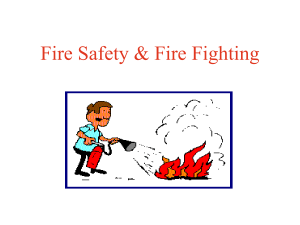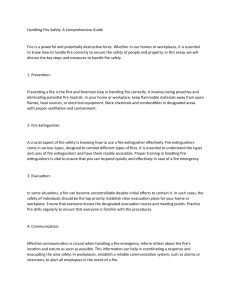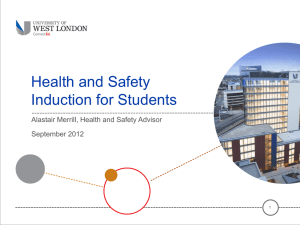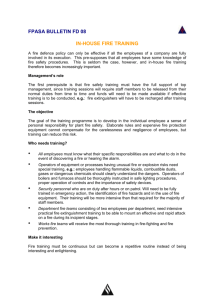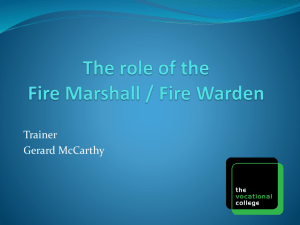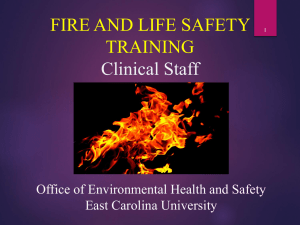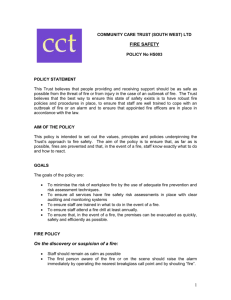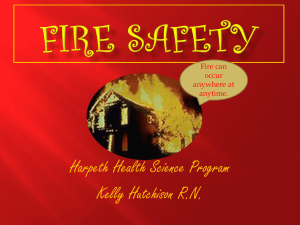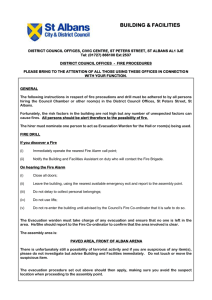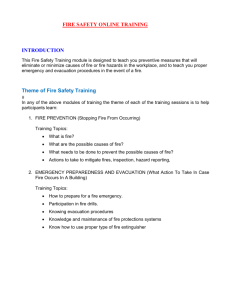Click here to
advertisement
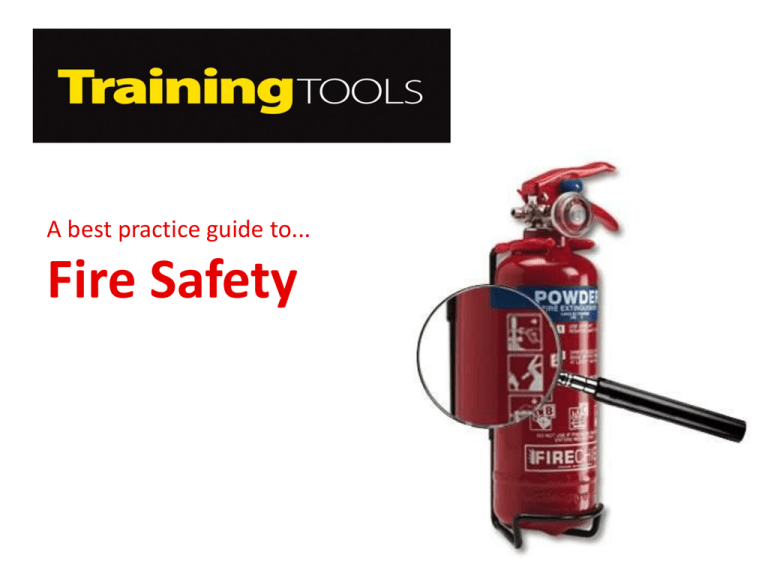
A best practice guide to... Fire Safety The aim of this presentation... Overview of the Regulations The cause of fire Fire hazards and prevention Actions to take on discovering a fire Evacuation Fire Precautions Overview of the Regulations • Regulatory Reform (Fire Safety) Order 2005. • Management of Health & Safety at Work Regulations 1999. Who do the Regulations apply to? All workplaces in England and Wales are affected and must comply. Workplaces in Scotland fall under the Fire (Scotland) Act 2005. The ‘responsible person’ The ‘responsible person’ of the workplace, (usually the employer) has a responsibility to safeguard their employees and other people entering their premises. Employees are responsible for adhering to their employer's policies and procedures in relation to fire safety precautions. Penalties The Fire Officer has the power to instigate a prosecution. An offence carries substantial penalties of up to £20,000 and in some cases PRISON SENTENCES (or even both). What causes a fire to start? 3 ingredients are required in for a fire to start, this is called The Triangle of Fire Heat: A source of ignition such as a heating element Fuel: Items that will burn such as furniture, paper, oil etc Oxygen: Air How can you help prevent fires? Eliminate Heat Eliminating sources of heat can prevent fires from starting. Don’t leave sources of heat, such as cooking rings, unattended. Starve Fuel Fuel is what keeps the fire going, this includes paper and furniture. The key to preventing fires is to keep fuel sources away from heat. Smother Oxygen Removing the oxygen will extinguish the fire. By keeping doors and windows closed, the supply of oxygen will be restricted and slow down the fire. Housekeeping Good housekeeping can prevent most fires from occurring. • Untidy workplaces make it easy for fires to start and spread. • Switch off and unplug any unnecessary electrical appliances when not in use, especially at the end of the day or at the start of a weekend. Electrical Hazards Ensure all electrical equipment is in a good state of repair… Don’t overload plug sockets and extension leads. Don’t use extension leads for a long period of time. Don’t run cables under carpets/mats. Don’t use appliances with damaged cables – they cause fires and electrocution. Do provide adequate ventilation to electrical appliances. Do turn off the supply if an electrical item becomes very hot. General Hazards Do keep all sources of fuel away from potential ignition sources. Do lock away cleaning fluids which may be flammable. If in doubt, REPORT IT! Discovering a Hazard If you see a potential hazard… 1. Report the hazard to your line manager or responsible person. 2. Make a record of the date, time and the person who you reported it to. Remember, the Fire Authority Officer has a legal right to inspect your workplace at any reasonable time Evacuation In the event of a fire: • Head to your fire exit route and follow the green running man signs. • Encourage others to leave with you, do not waste any time arguing with others to leave. • Go to the Fire Assembly Point and report to a fire warden. • Report any person and their location if they did not leave. You should familiarise yourself with the fire exit routes in your building Evacuation In the event of a fire follow these simple guidelines to minimise risk: 1. Raise the alarm by operating the break glass alarm and calling “Fire!” 2. Encourage prompt evacuation using the nearest exit route. 3. Lifts must NOT be used for evacuation under any circumstances. 4. If someone refuses to leave the building report their position to the fire warden or the fire brigade. Evacuation (continued) 5. Meet at the assembly point for roll call and inform the fire warden of any missing people and their possible location. 6. Await the arrival of the Fire Brigade. 7. The fire Marshall will liaise with the Fire Brigade. 8. Do Not Re-Enter the building until told it is safe to do so by the Fire Brigade or your Manager. Fire Precautions Fires produce smoke which can KILL in seconds. • Keep fire doors closed when not in use. • Keep Fire Exits clear of any obstructions and unlocked at all times whenever the building is in use. • Fire alarm call points, fire extinguishers, emergency lights and safety signs are there for your protection – Do not obstruct them. Locked and blocked fire exits are potential killers, unlock and KEEP CLEAR Fire Extinguishers Fire Extinguishers are for the use of trained personnel only • Never obstruct a Fire Extinguisher. • An extinguisher should only be removed from its stand/bracket for checking, testing or fire-fighting – it should ALWAYS be replaced afterwards. • If an extinguisher missing, defective or damaged REPORT IT. In the event of fire… Do NOT take any personal risks Raise the Alarm Get out, get everyone else out, and STAY OUT Under No Circumstances Should You Take Any Personal Risks For all your fire equipment needs… From Fire Extinguishers and Call Points, to Risk Assessment and Safety Training... Seton has everything you need to help your business comply. For a huge range of Fire Safety products, go online to www.seton.co.uk or call us FREE on 0800 585501
